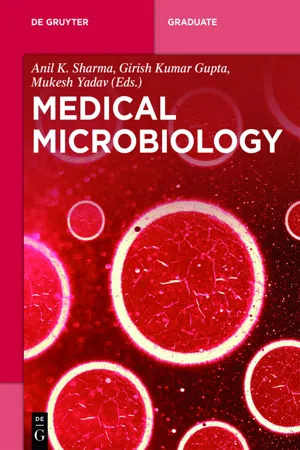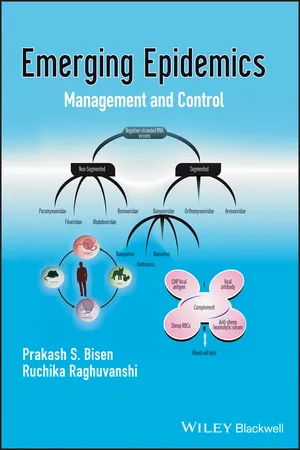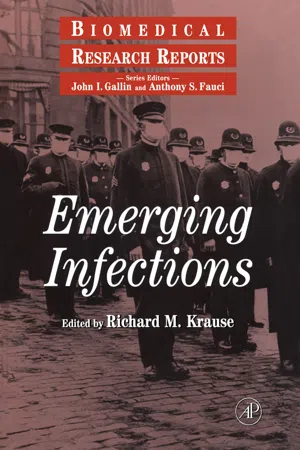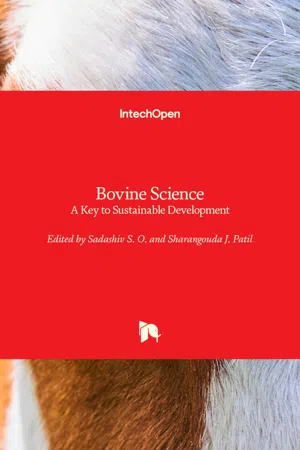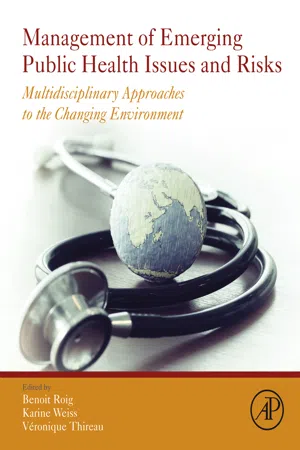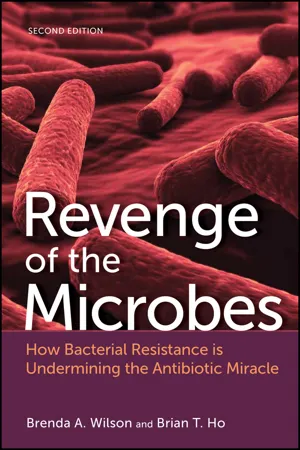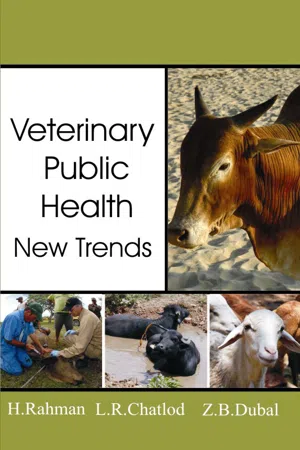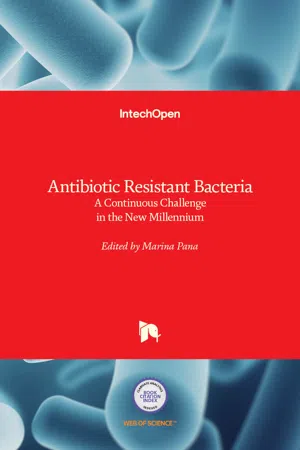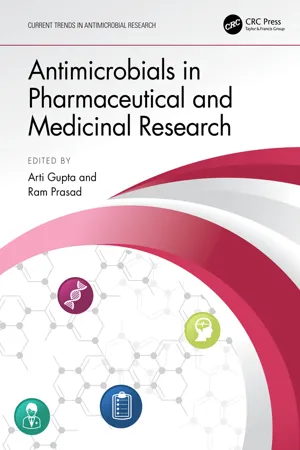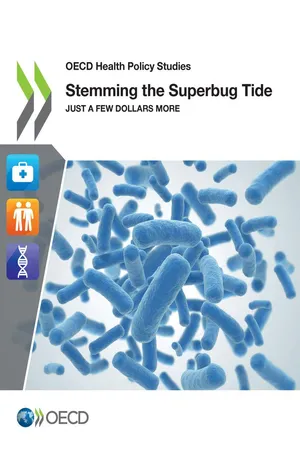Biological Sciences
Antimicrobial Resistance
Antimicrobial resistance refers to the ability of microorganisms, such as bacteria, viruses, and parasites, to evolve and become resistant to the drugs used to treat infections they cause. This resistance can lead to ineffective treatments, increased healthcare costs, and higher mortality rates. It is a growing global concern that requires coordinated efforts to develop new antimicrobial drugs and promote responsible use of existing ones.
Written by Perlego with AI-assistance
Related key terms
1 of 5
12 Key excerpts on "Antimicrobial Resistance"
- eBook - ePub
- Anil K. Sharma, Girish Kumar Gupta, Mukesh Yadav, Anil K. Sharma, Girish Kumar Gupta, Mukesh Yadav(Authors)
- 2022(Publication Date)
- De Gruyter(Publisher)
Chapter 7 Antimicrobial Resistance: medical science facing a daunting challengeAnil KumarDepartment of Microbiology , DAV University , Jalandhar , IndiaShailja SankhyanDepartment of Biotechnology , Chandigarh University Gharuan , Mohali , IndiaAbhishek WaliaDepartment of Microbiology , CSK Himachal Pradesh Agricultural University , Palampur , IndiaChayanika PutatundaDepartment of Microbiology , DAV University , Jalandhar , IndiaDharambir KashyapDepartment of Histopathology , Postgraduate Institute of Medical Education and Research , Chandigarh , IndiaAjay SharmaDepartment of Chemistry , Career Point University , Tikker-Kharwarian, Hamirpur , IndiaAnil K SharmaDepartment of Biotechnology , Maharishi Markandeshwar (Deemed to be University) Mullana , Ambala , IndiaAbstract
Antimicrobial Resistance (AMR) is the potential of the microorganisms to resist the impacts of medicine/drugs that once could positively treat the microbial infection. The resistant microorganisms are hard to treat, may require elevated antimicrobial doses or alternative medications. Resistance arises through several mechanisms including natural resistance, by one species acquiring resistance from another or genetic mutation. All types of microorganisms including fungus, viruses, bacteria and protozoa can develop resistance. The increasing resistance among microbes is a major concern among medical microbiologists and other researchers related to the field. This chapter covers the AMR development among microbes including possible mechanisms, biochemical and molecular cascades.Keywords: microbes, Antimicrobial Resistance, genetic mutation, mechanism of Antimicrobial Resistance,7.1 Introduction
The potential of microbes to attain resistance has been well known soon after the discovery of penicillin by Alexander Fleming, and today resistance has developed to almost every antibiotic launched. In the golden era (1940–1990) of antibiotics, numerous classes including aminoglycosides, tetracyclines, glycopeptides, polymyxins, macrolides, β-lactam antibiotics and fluoroquinolones were developed [1 , 2 ]. However, the effective role of antibiotics addressing bacterial infections was taken for granted because of which new microbes have emerged that are capable of destroying the antibiotics negating its effects. This has significantly increased the mortality, morbidity and healthcare cost [2 , 3 - eBook - ePub
Emerging Epidemics
Management and Control
- Prakash S. Bisen, Ruchika Raghuvanshi(Authors)
- 2013(Publication Date)
- Wiley-Blackwell(Publisher)
People infected with drug-resistant organisms are more likely to have longer hospital stays and may die as a result of infection. In case the drug of choice for treating their infection does not work, these patients require treatment with second or third choice drugs, which may be less effective, more toxic, and more expensive. This suggests that patients with an antimicrobial-resistant infection may suffer more and pay more for treatment.Global Scenario
Drug resistance actually follows the evolutionary laws of Darwin, which states that the excessive use of antimicrobials creates a selection pressure on microorganisms and as a result, weaker organisms are killed and stronger organisms adapt and survive. When pathogenic microorganisms can multiply beyond some critical mass in the presence of antimicrobials, treatment outcome is compromised; this phenomenon is referred as Antimicrobial Resistance (AMR). AMR has been an underappreciated threat to public health in nations around the globe. It was initially observed as only being a human medical problem, especially in hospital-acquired infections, and usually only in critically ill and patients who were severely immunocompromised. Today, AMR has reached the point that the general population is considered to be at risk, bringing about an era where many common bacterial infections are becoming increasingly difficult to treat. One of the major contributing factors to this changing trend is the spillover of AMR from antibiotic use in poultry and livestock. AMR has become a global concern because geographic borders among countries and continents have become less distinct probably as a result of increasing global trade, expanding human and animal populations, societal advances, and technological developments. With this increasing global connectivity, there is now rapid transport of infectious agents and their AMR genes, which may consequently exert an impact throughout the world. With the increasing observations of AMR, on World Health Day (WHD) 2011, a six-point policy package was declared in which countries were called upon to:1. Commit to a comprehensive, financed national plan with accountability and civil society engagement. 2. Strengthen surveillance and laboratory capacity. 3. Ensure uninterrupted access to essential medicines of assured quality. - eBook - PDF
- John I. Gallin, Anthony S. Fauci(Authors)
- 1998(Publication Date)
- Academic Press(Publisher)
8 ANTIBIOTIC RESISTANCE IN BACTERIA JULIAN DAVIES and VERA WEBB Department of Microbiology and Immunology University of British Columbia Vancouver, British Columbia, Canada We must swim with the microbes and study their sur- vival and adaptation to new habitats. Richard M. Krause (1994) I. INTRODUCTION The development of antibiotic resistance can be viewed as a global problem in microbial genetic ecology. It is a very complex problem to contemplate, let alone solve, due to the geographic scale, the variety of environmental factors, and the enormous number and diversity of microbial participants. In addition, the situ- ation can only be viewed retrospectively, and what has been done was uncon- trolled and largely unrecorded. Simply put, since the introduction of antibiotics for the treatment of infectious diseases in the late 1940s, human and animal microbial ecology has been drastically disturbed. The response of microbes to the threat of extinction has been to find genetic and biochemical evolutionary routes that led to the development of resistance to every antimicrobial agent used. The result is a large pool of resistance determinants in the environment. The origins, evolution, and dissemination of these resistance genes is the subject of this review. II. MECHANISMS OF RESISTANCE: BIOCHEMISTRY AND GENETICS The use of antibiotics should have created a catastrophic situation for microbial populations; however, their genetic flexibility allowed bacteria to survive (and even thrive) in hostile environments. The alternatives for survival for threatened microbial populations were either mutation of target sites or acquisition of Emerging Infections Copyright © 1998 by Academic Press. All rights of reproduction in any form reserved. 239 - eBook - PDF
Bovine Science
A Key to Sustainable Development
- Sadashiv S. O., Sharangouda J. Patil, Sadashiv S. O., Sharangouda J. Patil(Authors)
- 2019(Publication Date)
- IntechOpen(Publisher)
Chapter 4 Emergence of Antimicrobial Resistance, Causes, Molecular Mechanisms, and Prevention Strategies: A Bovine Perspective Muhammad Ashraf, Behar-E -Mustafa, Shahid-Ur -Rehman, Muhammad Khalid Bashir and Muhammad Adnan Ashraf Additional information is available at the end of the chapter http://dx.doi.org/10.5772/intechopen.79757 Abstract Emergence of the resistance in microbial population is a major threat to both animal and human health. In bovine, the development of microbial resistance is a persistent threat for health especially in the form of zoonotic pandemics due to viral and multidrug bacterial resistance. Mechanisms of Antimicrobial Resistance in microbes are of natural as well as acquired origin. There are half dozen molecular mechanisms identified that possibly cause the emergence and transfer of Antimicrobial Resistance within and between different bacterial genera. These mechanisms include degradation of the antibacterial drug by the bacterial enzymes, reduced permeability of the drug by bacteria, increased efflux of the drug, modification of drug target and use of alternative pathways by bacterial cells. Various assays viz. disk diffusion test and E-test, focusing on minimum inhibitory con-centration of antimicrobials, have been employed to detect the Antimicrobial Resistance in microbes. The most important factor responsible for the development of multidrug resis-tance in bovine pathogenic microbes is irrational use of the antibiotics. Antibiotics are necessary evil, so judicious use of antibiotics, early detection of infections, vaccination, use of immune-modulators and medicinal plants or their derivatives are some of the strategies to reduce the possible emergence of Antimicrobial Resistance. Keywords: microbes, resistance, pandemic, zoonotic, antibiotic © 2019 The Author(s). - eBook - ePub
Management of Emerging Public Health Issues and Risks
Multidisciplinary Approaches to the Changing Environment
- Benoit Roig, Karine Weiss, Veronique Thireau(Authors)
- 2018(Publication Date)
- Academic Press(Publisher)
Antimicrobials have been a keystone component of the modern medical system since the introduction of sulfonamides in 1937, followed by the first therapeutic use of penicillin in 1942 to treat streptococcal infections, and streptomycin in 1944 for the treatment of tuberculosis. Antimicrobial therapy is one of the most significant medical advancements and largely responsible for the reduction in morbidity and mortality associated with infectious disease and routine medical practice. The ability of antimicrobial agents to combat deadly infections has long been evident, however, their use can promote the development of resistant strains (Davies and Davies, 2010). Sir Alexander Fleming, who discovered penicillin in 1925, warned of the threat of the development of Antimicrobial Resistance (AMR) during his Nobel Prize lecture in 1945 (Nobel Media AB, 2018). Public health is fundamental to human health and is aimed at preventing injury, illness, and premature death. It is a combination of programs, services, and policies that protect and promote the health of all (Last et al., 2001). It implies the management of health in populations through preventive actions and practice. Further, surveillance is and has been a long established backbone for public health, and a tool for understanding incidence and prevalence of disease, the emergence of pathogens, and, more recently, the emergence and dissemination of AMR. Global estimates and concerns indicate a large clinical and public health burden associated with AMR and a looming crisis ahead (Willyard, 2017). Globally, there are 700,000 deaths annually attributed to AMR (O'Neill, 2014). More recent projections suggest that there will be 10 million deaths by 2050 owing to infectious disease and widespread AMR (O'Neill, 2016) - eBook - PDF
Magic Bullets, Miracle Drugs, and Microbiologists
A History of the Microbiome and Metagenomics
- William C. Summers(Author)
- 2024(Publication Date)
- ASM Press(Publisher)
Detailed biochemical studies of the actions of antimicro- bials have led to the understanding of the many ways in which microbes evolve to become resistant to such agents. ANTIBIOTIC RESISTANCE IN THE CURRENT CONTEXT The successes of wonder drugs against infectious diseases in the 1950s and 1960s exposed several unanticipated circumstances. These were scientific, environmen- tal, and economic. First, the fact that many of the newly discovered antibiotics were “broad spectrum” led physicians to become casual about the need to iden- tify the particular offending pathogenic microbe and prescribe the appropriate therapy. The practice of identifying a pathogen by laboratory cultures followed by checking its sensitivity to a proposed therapy gave way in everyday practice to the “therapeutic trial” approach: treat with a broad spectrum antibiotic and if the patient is cured, the identification of the pathogen was of only “academic interest.” A corollary of this approach is that antibiotics became widely used for diseases that were not bacterial but viral in origin. The antibiotics in common use were known to be ineffective against viral diseases because viruses are of a totally dif- ferent biological realm. This practice inadvertently increased the antibiotic load in the biological environment leading to more unnecessary selective pressure on the normal microbial populations. Even if antibiotic resistance developed in innocu- ous bacteria, the phenomenon of lateral gene transfer meant that the resistance 42 • Magic Bullets, Miracle Drugs, and Microbiologists gene soon spread like a microbial epidemic into the more troublesome germs that would soon become a clinical problem. A phenomenon associated with casual antibiotic use had been foreseen by Ehrlich himself, the problem of insufficient dosages that then allowed for step-wise resistance to develop. - eBook - PDF
Revenge of the Microbes
How Bacterial Resistance is Undermining the Antibiotic Miracle
- Brenda A. Wilson, Brian T. Ho(Authors)
- 2023(Publication Date)
- ASM Press(Publisher)
27 Revenge of the Microbes: How Bacterial Resistance Is Undermining the Antibiotic Miracle, Second Edition. Brenda A. Wilson and Brian T. Ho. © 2023 American Society for Microbiology. The monumental advances in modern medicine made possible by antibiotics sparked an exciting new era of drug discovery. The race was on to expand our reper- toire of antibiotics capable of treating life-threatening infectious diseases. It was quickly discovered that many soil bacteria and fungi naturally produce compounds with antimicrobial properties, which prompted pharmaceutical companies to engage in large-scale screening efforts to find novel lead compounds that could be modified into effective antibiotics. Ultimately, for nearly 30 years after the discovery of penicil- lin, the market was continuously flooded with new antibiotics. As exciting as these new discoveries were, unfortunately, they ended up masking a growing problem: antibiotic resistance. Essentially, the deluge of new drugs meant that health care pro- viders were able to rely on there always being at least one antibiotic that could treat every infection, despite bacterial resistance to these drugs developing rather quickly. Only after new antibiotic discovery began to slow down did the rosy picture of anti- biotics completely solving all our infectious disease woes finally begin to crumble. ANTIBIOTIC RESISTANCE BECOMES A GROWING PROBLEM In the years immediately following the advent of antibiotics, academic researchers and some clinicians quickly began to notice that several clinically important bacteria had a high propensity to rapidly develop mechanisms for resisting the antibiotics used to treat them. In some cases, these bacteria would become resistant to a new antibiotic within just a few short years of the drug being first deployed (Table 3.1). Bacterial Resistance Threatens the Mighty Reign of Antibiotics 3 - eBook - PDF
- Rahman, H(Authors)
- 2021(Publication Date)
- Biotech(Publisher)
The antibiotic, by suppressing their normal microbiota, renders them more vulnerable to infection. Second mechanism involves the linkage of virulence traits to resistance traits so that resistant organisms may be more virulent than susceptible organisms. A third mechanism is that treatment may be rendered ineffective by the choice of a drug to which the pathogens are resistant. Fourth mechanism is that the resistant pathogens from food animals may then be transmitted through the food chain to humans. Last, resistance traits can be acquired by the commensal flora of animals and from this reservoir, resistance traits could find their way through the food chain to commensals and pathogens of humans [Barza, 2002]. MOLECULAR GENETIC FACTORS IN EMERGENCE AND DISSEMINATION OF ANTIBIOTIC RESISTANCE The emergence and spread of multiple resistant organisms represent the This ebook is exclusively for this university only. Cannot be resold/distributed. convergence of a variety of factors that include mutations in common resistance genes that extend their spectrum of activity; the exchange of genetic information among microorganisms in which resistance genes are transmitted to new hosts; the development of environmental conditions in hospitals and communities (selective pressures) that facilitate the development and spread of resistant organisms; the proliferation and spread, in some cases globally, of multiply resistant clones of bacteria; and the inability of some laboratory testing methods to detect emerging resistance phenotypes (Tenovar and Hughes, 1996., Doern et al ., 1998, Levin et al ., 1997). ROLE OF MUTATIONS IN EMERGENCE OF ANTIBIOTIC RESISTANCE In the early days of the “antibiotics,” it was assumed that the development of resistance to antibiotics is a function of mutational events in the bacterial chromosome. - eBook - PDF
Antibiotic Resistance
Origins, Evolution, Selection and Spread
- Derek J. Chadwick, Jamie A. Goode, Derek J. Chadwick, Jamie A. Goode(Authors)
- 2008(Publication Date)
- Wiley(Publisher)
Microbes that once were easily controlled by antimicrobial drugs are, more and more often, causing infections that no longer respond to treatment with these drugs.’ Trends in resistance Antimicrobial Resistance has almost always followed the introduction of a new drug. At first drug-resistant infections were recognized as a problem only in hospital- acquired infections. With each passing decade, resistance has become an increasingly serious problem for hospitals and for clinicians who treat infections acquired in the community (Cohen 1992). In the hospital, resistance poses a significant problem for treating infections caused by Enterococcus species, Mycobacterium tuberculosis, Gram-negative rods and StapLy/ococcu.r species. Certain strains of enterococci and M. tuberculosis are already essentially untreatable with antimicrobial agents. For enterococci, which are intrinsically resistant to many other antimicrobial agents, the emergence of vancomycin resistance has posed an even greater therapeutic challenge. By early 1993, almost 14% of enterococci isolated from patients in intensive care units in a sample of US hospitals were resistant to vancomycin (Centers for Disease Control 1993a). The re- emergence of tuberculosis in the USA, beginning in the mid-l980s, has been associated with clusters of nosocomial outbreaks caused by strains resistant to several standard antituberculosis agents (Centers for Disease Control 1991). Among the Gram- EPIDEMIOLOGICAL FACTORS 225 negative rods and the staphylococci, many strains are susceptible to only one antimicrobial agent. Of particular concern are strains of methicillin-resistant Staphylococcus aureus (MRSA), which have become increasingly prevalent in both community and large teaching hospitals, accounting for 2WO% of the staphylococci isolated in a sample of US hospitals (Panlilio et a1 1992). - eBook - PDF
Antibiotic Resistant Bacteria
A Continuous Challenge in the New Millennium
- Marina Pana(Author)
- 2012(Publication Date)
- IntechOpen(Publisher)
It is not well understood to what extent the antimicrobials from animal manure can contribute to development of AMR in environment. However, some researchers showed that microbial populations in soil and water bodies could be affected by antimicrobial-containing manure (Campagnolo et al., 2002; Kong et al., 2006; Martinez, 2009). Antimicrobial Resistance is becoming an increasing health concern because antimicrobial-resistant commensal bacteria function as a huge resistance reservoir and can spread AMR to the environment and humans. Antimicrobial Resistance can be transferred to human by bacteria that can survive in both animals and humans. And greater concerns come from the possibility of AMR transfer from bacteria of animal origin to those in humans. Additionally, the microbiomes present in water, soil, and crops should also be taken into consideration because the dynamics and population structure of their microbial communities can be affected by animal wastes. Although it remains to be determined if environmental AMR reservoir can serve as an intermediate between AMR genes between bacteria of animals and humans (Canton, 2009; Wright, 2010), some in -vitro studies did indicate possible exchange of Antimicrobial Resistance Arising from Food-Animal Productions and Its Mitigation 473 AMR genes between soil bacteria and bacterial of animal origin via broad host-range plasmids (Heuer & Smalla, 2007; Smalla et al., 2000). Horizontal transfer of AMR genes can occur among bacteria that are not phylogenetically closely related, and such HGT aggravates the concern. In recent years, numerous studies have been reported on the emergence of multiple drug resistance and its linkage to the mobile genetic elements. Although no proof has been found of exchange of genes between environmental bacteria and human intestinal microbiota, the risk remains. - Arti Gupta, RAM PRASAD, Arti Gupta, RAM PRASAD(Authors)
- 2023(Publication Date)
- CRC Press(Publisher)
10.3389/fmicb.2021.718774- Maryam L , Usmani SS, Raghava GPS. Computational resources in the management of antibiotic resistance: Speeding up drug discovery. Drug Discov Today . 2021;26(9):2138–2151. doi: 10.1016/j.drudis.2021.04.016
- Matlock A , Garcia JA, Moussavi K, Long B, Liang SY. Advances in novel antibiotics to treat multidrug-resistant gram-negative bacterial infections. Intern Emerg Med . 2021;16(8):2231–2241. doi:10.1007/s11739-021-02749-1
- Melenotte C , Pontarotti P, Pinault L, Mège JL, Devaux C, Raoult D. Could β-Lactam Antibiotics Block Humoral Immunity?. Front Immunol. 2021;12:680146. Published 2021 Sep 15. doi:10.3389/fimmu.2021.680146
- Miklasińska-Majdanik M . Mechanisms of resistance to macrolide antibiotics among staphylococcus aureus. Antibiotics (Basel) . 2021;10(11):1406. doi:10.3390/antibiotics10111406
- Mohamed S , Mvungi HC, Sariko M, Rao P, Mbelele P, Jongedijk EM, van Winkel CAJ, Touw DJ, Stroup S, Alffenaar JC, Mpagama S, Heysell SK. Levofloxacin pharmacokinetics in saliva as measured by a mobile microvolume UV spectrophotometer among people treated for rifampicin-resistant TB in Tanzania. J Antimicrob Chemother . 2021;76(6):1547–1552. doi:10.1093/jac/dkab057
- Mohanty H , Pachpute S, Yadav RP. Mechanism of drug resistance in bacteria: efflux pump modulation for designing of new antibiotic enhancers. Folia Microbiol (Praha) . 2021;66(5):727–739. doi:10.1007/s12223-021-00910-z
- Mphahlele MJ . Synthesis, structural and biological properties of the ring-a sulfonamido substituted chalcones: A review. Molecules . 2021;26(19):5923. doi:10.3390/molecules26195923
- Mullis MM , Rambo IM, Baker BJ, Reese BK. Diversity, ecology, and prevalence of antimicrobials in nature. Frontiers in microbiology , 2019:2518. https://doi.org/10.3389/fmicb.2019.02518
- Naujokat C , Steinhart R. Salinomycin as a drug for targeting human cancer stem cells. J Biomed Biotechnol.
- eBook - PDF
- OECD(Author)
- 2018(Publication Date)
- OECD(Publisher)
Factors such as malnourishment, a high burden of HIV, or malaria found in some populations in LMICs, put these populations at particular risk for infectious diseases (Katona and Katona ‐ Apte, 2008 [88] ). Investing in measures for greater overall population level health such as increased health care access is an important strategy in lowering the infectious disease burden. 2.10. How can promoting prudent use of antimicrobials decrease AMR? A number of existing strategies to reduce the burden of AMR focus on reducing the use of antimicrobials. These may include public health campaigns, doctor training, or the use of delayed prescriptions. These strategies rely on both a decrease in the “upward” selection pressure toward higher resistance, and an i ncrease in the “downward” selection pressure toward less resistance through the relative bacterial fitness of resistant and susceptible bacteria to be effective. 2.10.1. Reducing “upward” resistance selection AMR develops through a system of natural selection where bacteria or other organisms adapt to their environment through resistance development in response to the selection pressure exerted by the presence of antimicrobials (see Section 2.2). The presence of antibiotics pushes resistance rates “upward” by killing susceptible bacteria and providing an environment available only to resistant bacteria. Antibiotics also promote gene transfer including resistant genes to increase resistance rates (see Box 2.3). Continued presence of antibiotics in an environment will put continued pressure on bacteria pushing them toward greater and greater resistance levels (Baym et al., 2016 [89] ). Removal or reduction of antibiotics will thus remove or reduce this upward pressure and slow or stop increasing resistance. 2.10.2. Increase “downward” selection for susceptibility While removing antibiotics may stop resistance rates from increasing, a second mechanism is needed for rates to decrease.
Index pages curate the most relevant extracts from our library of academic textbooks. They’ve been created using an in-house natural language model (NLM), each adding context and meaning to key research topics.
